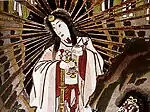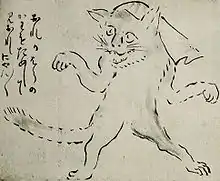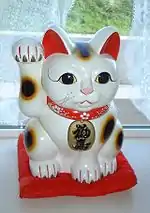Kaibyō
Kaibyō (かいびょう, "strange cat")[1] are supernatural cats in Japanese folklore.[2] Examples include bakeneko, a yōkai (or supernatural entity) commonly characterized as having the ability to shapeshift into human form; maneki-neko, usually depicted as a figurine often believed to bring good luck to the owner; and nekomata, referring either to a type of yōkai that lives in mountain areas or domestic cats that have grown old and transformed into yōkai.
| Part of a series on |
| Japanese mythology and folklore |
|---|
 |
| Mythic texts |
| Divinities |
| Legendary creatures and urban legends |
| Mythical and sacred locations |
| Sacred objects |
| Shintō and Buddhism |
The reason that cats are often depicted as yōkai in Japanese mythology can be attributed to many of their characteristics: for example, the irises of their eyes change shape depending on the time of day; their fur can seem to cause sparks when they are petted (due to static electricity); they sometimes lick blood; they can walk without making audible sounds; their sharp claws and teeth; their nocturnal habits; and their speed and agility.[3][4]
Types
Bakeneko

The bakeneko (化け猫, "changed cat") is a yōkai that appears in legends in various parts of Japan. Its characteristics and abilities vary, from being able to shapeshift into human form,[5][6] speak human words,[5][7] curse or possess humans,[8] and manipulate dead people,[8] to wearing a towel or napkin on its head and dancing.[5][7]
Maneki-neko

The maneki-neko (招き猫, lit. 'beckoning cat'), or "lucky cat", is commonly depicted as a figurine, often believed to bring good luck to the owner. It is typically depicted as a calico Japanese Bobtail holding a koban coin, with a paw raised in a Japanese beckoning gesture. The figurines are often displayed in shops, restaurants, pachinko parlors, laundromats, bars, casinos, hotels, nightclubs, and other businesses, generally near the entrance.
Nekomata
Nekomata (original form: 猫また, later forms: 猫又, 猫股, 猫胯) refers either to a type of cat yōkai that lives in mountain areas, or to domestic cats that have grown old and transformed into yōkai.[9]
In film
"Monster cat" or "ghost cat" films (kaibyō eiga or bake neko mono) are a subgenre of Japanese horror films featuring kaibyō, derived primarily from the repertoire of kabuki theatre.[10] The subgenre first gained popularity prior to World War II; its popularity declined after the war, arguably because Japanese audiences no longer believed in or feared such entities.[10] However, the subgenre experienced a resurgence of popularity in the 1950s and 1960s due to actress Takako Irie appearing in "monster cat" film roles.[10] Films featuring depictions of kaibyō include:
- Arima Neko (1937)[11][12]
- The Ghost Cat and the Mysterious Shamisen (1938)[12][13]
- Ghost Cat of Nabeshima (1949)[14][15]
- Ghost of Saga Mansion (1953)[15]
- Ghost-Cat of Arima Palace (1953)[15]
- Ghost Cat of the Okazaki Upheaval (1954)[15]
- The Ghost Cat of Ouma Crossing (1954)[15]
- Ghost-Cat of Gojusan-Tsugi (1956)[16]
- Ghost Cat of Yonaki Swamp (1957)[17]
- Ghost-Cat Wall of Hatred (1958)[16]
- Black Cat Mansion (1958)[15][18]
- The Ghost Cat of Otama Pond (1960)[18]
- Kuroneko (1968)[18]
- The Ghost-Cat Cursed Pond (1968)[19]
- Blind Woman's Curse (1970)[15]
- House (1977)[20]
References
- Macalanda, Dana (28 October 2017). "'Kaibyo: The Supernatural Cats of Japan': Traditionally spooky felines". The Japan Times. Retrieved 13 July 2021.
- Davisson, Zack (2017). Kaibyō: The Supernatural Cats of Japan. Chin Music Press Inc. ISBN 978-1634059169.
- 笹間1994年、125–127頁。
- 古山他2005年、156–161頁。
- 松谷1994、171–174頁。
- 松谷1994、194–207頁。
- 松谷1994、214–241頁。
- 鈴木1982年、446–457頁。
- 多田 (2000)、170–171頁。
- Curran, Sato-Rossberg & Tanabe 2015, p. 30.
- Dannery, Letizia (31 May 2018). "Enfer et damnation au Quai Branly". L'Express (in French). Archived from the original on 13 July 2021. Retrieved 13 July 2021.
- Fujiki, Hideaki; Phillips, Alastair, eds. (2020). The Japanese Cinema Book. British Film Institute. p. 301. ISBN 978-1-8445-7678-4.
- Sharp 2011, p. 86.
- Tombs, Pete (1998). Mondo Macabro: Weird & Wonderful Cinema Around the World. St. Martin's Griffin. p. 169. ISBN 978-0312187484.
- Sharp 2011, p. 87.
- Sharp 2011, p. 122.
- Sharp 2011, p. 87, 122.
- McDonagh, Maitland (17 October 2011). "Kuroneko: The Mark of the Cat". The Criterion Collection. Retrieved 13 July 2021.
- Marak, Katarzyna (2014). Japanese and American Horror: A Comparative Study of Film, Fiction, Graphic Novels and Video Games. McFarland & Company. p. 101. ISBN 978-0786496662.
- Stephens, Chuck (26 October 2010). "House: The Housemaidens". The Criterion Collection. Retrieved 31 August 2021.
Bibliography
- Curran, Beverley; Sato-Rossberg, Nana; Tanabe, Kikuko, eds. (2015). Multiple Translation Communities in Contemporary Japan. Routledge. ISBN 978-1-138-83170-4.
- Sharp, Jasper (2011). Historical Dictionary of Japanese Cinema. Scarecrow Press. ISBN 978-0810857957.
- 笹間良彦 (1994). 図説・日本未確認生物事典. 柏書房. ISBN 978-4-7601-1299-9.
- 多田克己 (2000). 京極夏彦・多田克己編 (ed.). 妖怪図巻. 国書刊行会. ISBN 978-4-336-04187-6.
- 鈴木棠三 (1982). 日本俗信辞典 動・植物編. 角川書店. ISBN 978-4-04-031100-5.
- 古山桂子他 (2005). 播磨学研究所編 (ed.). 播磨の民俗探訪. 神戸新聞総合出版センター. ISBN 978-4-343-00341-6.
- 松谷みよ子 (1994). 現代民話考. Vol. 10. 立風書房. ISBN 978-4-651-50210-6.